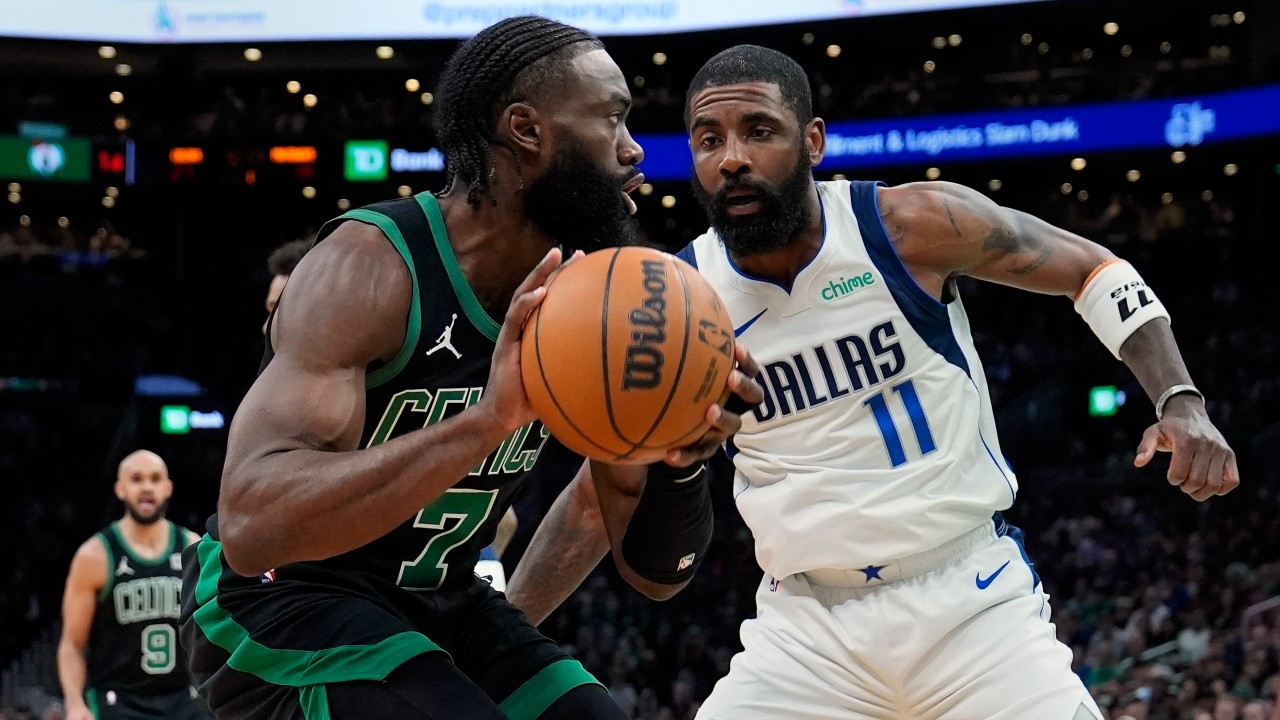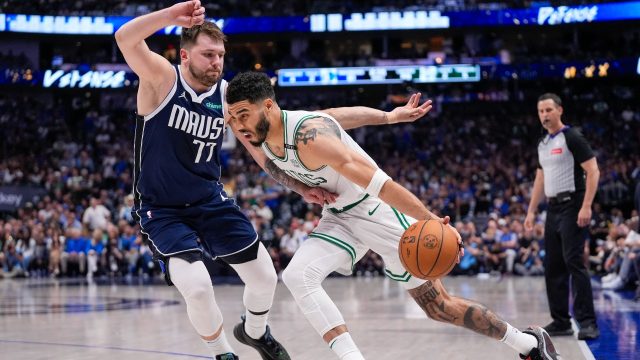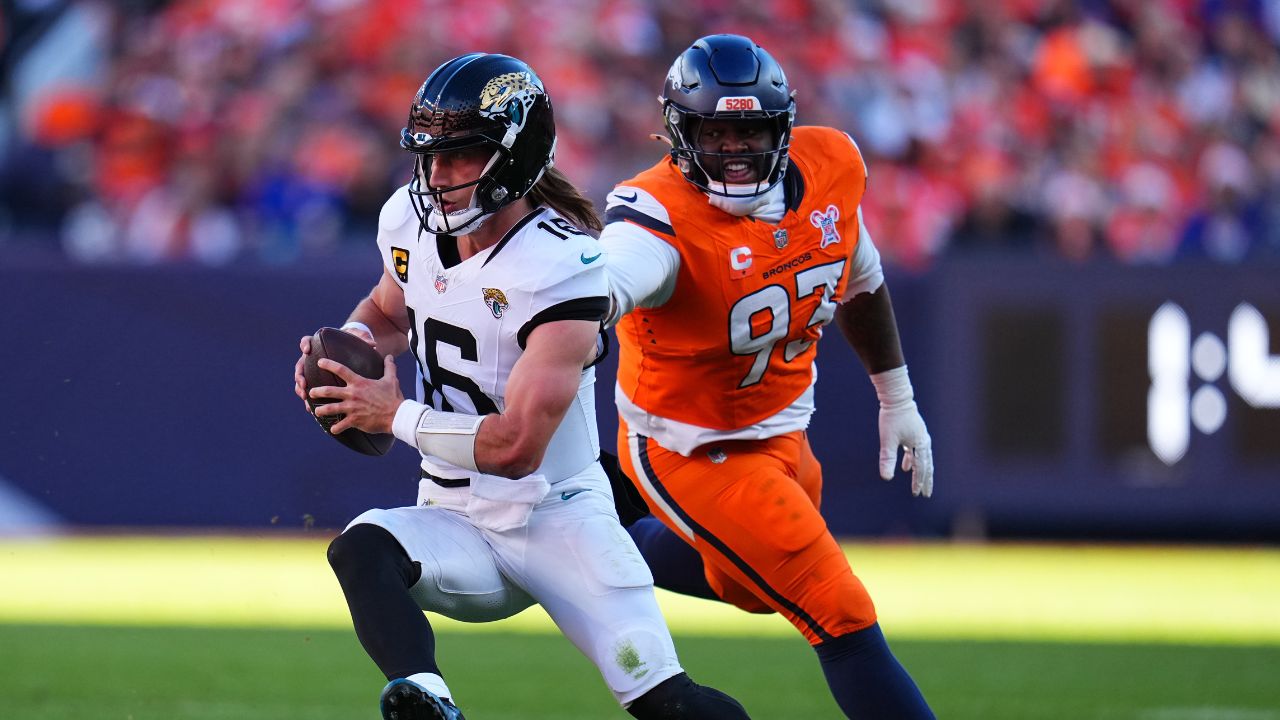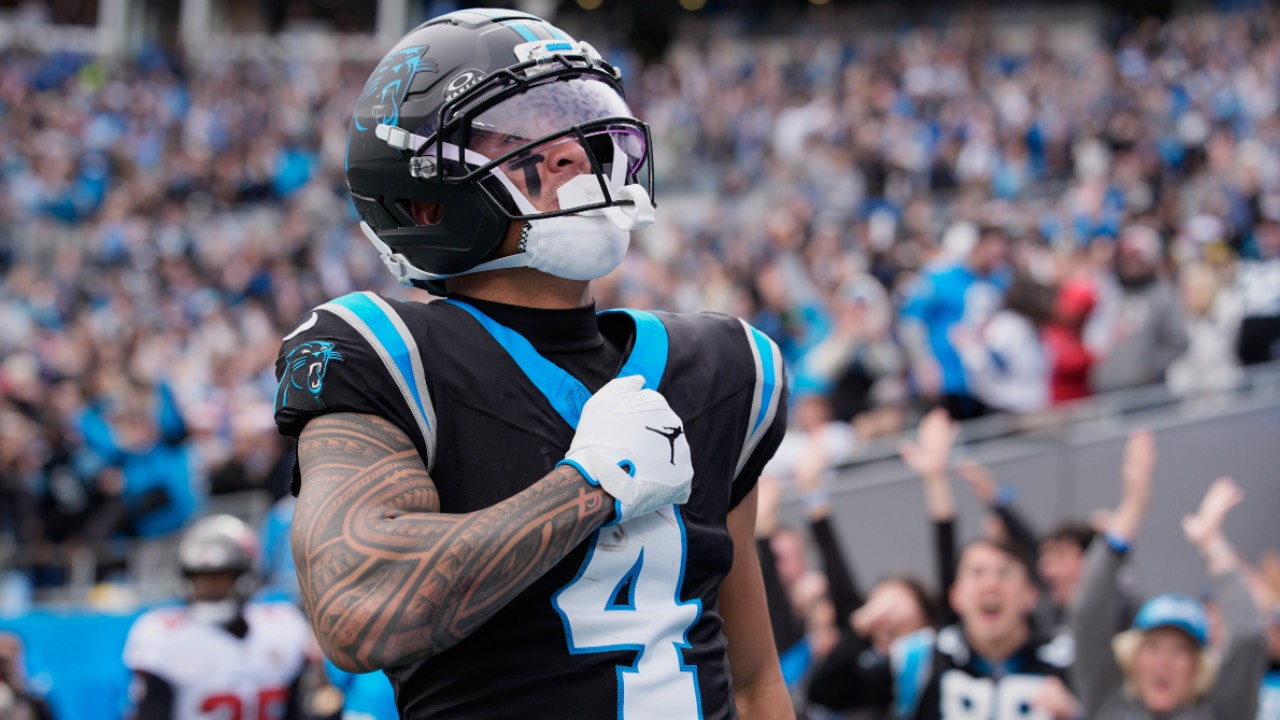
The Boston Celtics are getting better as they go along in the playoffs and now are on the brink of being the last team standing.
The Celtics weathered a loud Dallas crowd, a superstar-level performance from Kyrie Irving and a blistering fourth-quarter Mavericks comeback to win 106-99 and take a 3-0 lead in the NBA Finals, a hole that no team has climbed out from in the history of the league.
Luka Doncic had 27 points, six assists and six rebounds before he fouled out with 4:12 to play. Dallas was trailing by three at the time, having stormed back from 21 points down in the fourth quarter. Dallas pulled within one as Irving scored the last field goal on what ended up being a 35-point explosion for the Dallas guard. But Boston held firm as Celtics stars Jaylen Brown and Jayson Tatum — with 30 and 31 points respectively and 13 combined assists — took Boston over the line.
The series could be finished by Game 4 on Friday as the Celtics, winners of 10 straight post-season games, try to win their NBA record 18th championship.
Some takeaways:
Mavericks can’t capitalize on injury to Porzingis
Not many teams can afford to lose a seven-foot-three centre who delivered 20.1 points, seven rebounds, two assists and nearly two blocks a game during the regular season, but the Celtics have managed well even when Kristaps Porzingis has been out of the lineup.
Boston went 9-1 during their run through the Eastern Conference playoffs after Porzingis went to the bench with a calf injury four games into the first round.
That said, they’ve been a lot better with him available and on the floor and Porzingis showed his value when he returned to action in the Finals. Boston was plus-25 with the big Latvian on the court in his 43 minutes in this series and only even with Dallas when he sat.
For that reason, the fact that Porzingis was unavailable for Game 3 due to a tendon injury in his lower left leg created an opportunity for Dallas. And certainly, Irving and Doncic tried to take advantage, attacking the paint without worrying about Porzingis lurking. As well, Mavericks centres Dereck Lively and Daniel Gafford had their best games of the series, contributing on both ends. They combined to go 8-of-9 from the floor and add 16 rebounds. Without having to account for Porzingis’ three-point threat, they had more opportunity to patrol the paint and protect the rim.
And it still didn’t matter.
Al Horford, at age 38 and in his 17th season, was effective in his 37 minutes, somehow having the legs to stick with Irving for a key perimeter stop late in the fourth quarter. Xavier Tillman hit a crucial corner three and was plus-nine in his 11 minutes. The Celtics machine is proving too deep, with or without Porzingis.
Threes start to fall
No team has been more committed to three-point shooting than the Boston Celtics since Joe Mazzulla took over as head coach to start the 2022-23 season. They were second in threes attempted that year and then moved up to first in threes attempted this past season, connecting on 16.5 per game. They were good for a very healthy 38.8 per cent conversion rate, which was just fractionally behind the Oklahoma City Thunder for top spot in the league.
However, Boston was misfiring through two games of the Finals, connecting on just 32 per cent of their three-point looks. They kept shooting, though, getting up 81 threes over the first two games, compared with 53 for Dallas (who were also lagging in makes as they shot just 24.5 per cent).
You had to figure the math would eventually even out and it finally did in the third quarter of Game 3. Boston went 5-of-11 from behind the line in that frame with five different players hitting from deep, keeping with their philosophy to make everyone on the floor a threat. The flurry turned a one-point halftime deficit into a 15-point Celtics lead to start the fourth quarter.
Going into the series there was a case to be made that Dallas would need to catch Boston on one of their ‘off’ shooting nights to have their best chance to win. The Celtics were 36-1 this season when they shot at least 40 per cent from three, and just 6-7 when they made just 12 threes or less. Dallas may have missed their chance in the first two games of the series, and the Celtics — 17-of-43 from deep on Wednesday — didn’t miss theirs in Game 3.
Doncic’s dreadful defence
Doncic is a basketball genius. Anytime the six-foot-seven, 230-pound point guard takes the floor his team has a chance to win. But even as a five-time first-team all-NBA selection he still has significant flaws in his game, and they may prevent him from winning at the highest level in his career.
Doncic can score, pass and rebound, but on far too many occasions he is a defensive liability. It was a major factor in Game 2 when the Celtics’ duo of Brown and Tatum made a point of attacking him on the dribble with great success and it was even more evident in Game 3 when Doncic allowed Boston to gain advantages big and small over and over again.
On consecutive possessions at the end of the first quarter, Doncic hit the ground after believing he got fouled and sat on his butt pleading his case with the referees rather than sprinting back defensively. The first instance led to an open three by the Celtics’ Sam Hauser, who pulled up as Doncic loped back. The other led to a runout dunk by Tatum to end the quarter, the final flurry helping cut Dallas’ lead to one at the end of the first.
There were plenty more examples, including losing track of Brown on the weak side as the Celtics wing cut to the rim for a dunk, and losing Brown and then requiring his teammates to help, leaving Tatum open for a three. But you could find some version of those plays on almost every possession.
Doncic is capable of defending — he looked the part when he stymied Tatum off the dribble on one early possession — and he’s certainly got the size and IQ to be at least competent. But too often he just doesn’t engage. Whether it’s because he’s tired from playing so many minutes or he’s not fit enough to play both ends given the offensive load he carries, who knows, but it’s hard to imagine Doncic winning an NBA title when he creates as many problems defensively as he solves with the ball in his hands.
Irving flashes his magic
Kyrie Irving finally showed up. He was optimistic he would, or at the very least wasn’t going to let his lack of impact in Games 1 and 2 — where he averaged just 14 points on 35 per cent shooting — carry over to Game 3 in Dallas.
“First thing of that is just accepting that I haven’t played well or up to my standards, as well as I would have liked,” Irving said between Games 2 and 3. “Being back in Boston, there’s such a level of desire that I have inside of me to play well. Wanted to be there for my teammates. As a competitor, it’s frustrating. But I don’t want to let that seep in or spill over to any other decisions I have to make there as a player. [I’m going to] continue to feed my teammates’ confidence.”
Just as in Game 2 Irving got off to a quick start, but unlike Game 2 when Irving disappeared after starting four-of-five from the floor, he was just getting warmed up with nine in the opening frame Wednesday. Irving bubbled over in a key sequence during the second quarter when he hit a trio of triples in the space of three minutes that allowed Dallas to maintain their advantage after a long drought in which Boston had gone on an 18-6 run that had cut the Dallas lead to one.
Dallas couldn’t hold Boston off entirely, but Irving’s 20 first-half points allowed them to hold that one-point lead going into halftime.
Two layers of depth for Celtics
Watching the Celtics roll through the Eastern Conference and now through the NBA Finals, it’s fair to ask, wait, how did they get all these excellent players? Why doesn’t [insert your favourite team here]have those players?
Well, there are two layers to this Celtics team that entered Game 3 in Dallas with a 78-20 record on the year, when their regular-season and playoff records are combined. The first is the foundation: Jayson Tatum and Jaylen Brown, the Celtics’ all-NBA wings who were each chosen third overall in 2016 and 2017, respectively, with assets Boston received in the blockbuster move that broke up their 2008 championship team by sending Paul Pierce and Kevin Garnett to the Nets.
Boston has been through a lot of players on teams that have been to six Eastern Conference Finals and two NBA Finals in eight seasons since they drafted Brown.
With that base of talent (along with Marcus Smart, who was chosen sixth overall in 2014, and Terry Rozier, taken 16th in 2015, among other keepers in subsequent drafts) Boston became competitive. They also became flexible, able to use their resources to make a couple of essential trades this past off-season. Smart was the centrepiece of a three-way trade with Memphis and Washington that netted the Celtics Porzingis. The Celtics also were able to trade Malcolm Brogdon, Robert Williams and a pair of first-round draft picks to Portland in the deal that brought in Jrue Holiday.
The trades get the headlines but adding stars and rotation-level players alike in every draft from 2014 to 2020 gave Boston the resources needed to make those transformational deals. Toronto Raptors fans know the script well. With Kyle Lowry and DeMar DeRozan anchoring their roster, Toronto was able to add Delon Wright, Norm Powell, Fred VanVleet, Jakob Poeltl, Pascal Siakam and OG Anunoby in the space of four drafts. Some of those players were part of a championship team, others were traded to make one.







